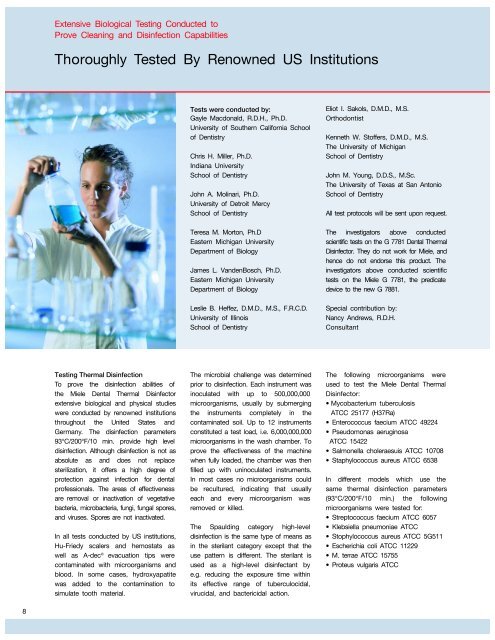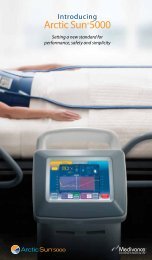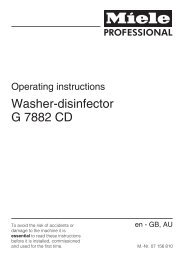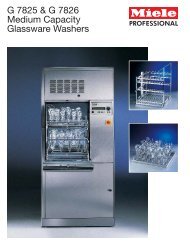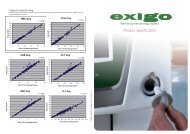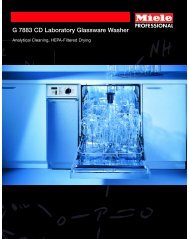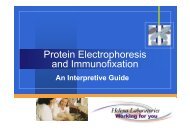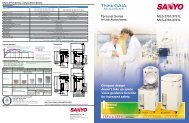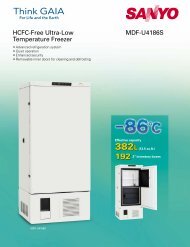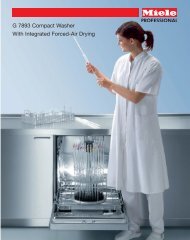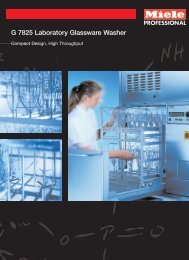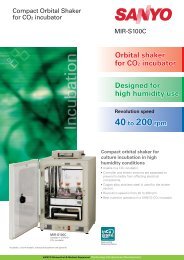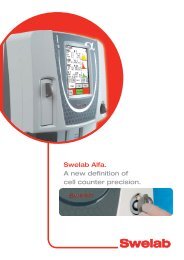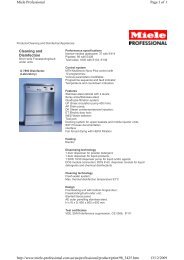G 7881 - Brochure - 2006 final.qxp
G 7881 - Brochure - 2006 final.qxp
G 7881 - Brochure - 2006 final.qxp
Create successful ePaper yourself
Turn your PDF publications into a flip-book with our unique Google optimized e-Paper software.
Extensive Biological Testing Conducted to<br />
Prove Cleaning and Disinfection Capabilities<br />
Thoroughly Tested By Renowned US Institutions<br />
Tests were conducted by:<br />
Gayle Macdonald, R.D.H., Ph.D.<br />
University of Southern California School<br />
of Dentistry<br />
Chris H. Miller, Ph.D.<br />
Indiana University<br />
School of Dentistry<br />
John A. Molinari, Ph.D.<br />
University of Detroit Mercy<br />
School of Dentistry<br />
Eliot I. Sakols, D.M.D., M.S.<br />
Orthodontist<br />
Kenneth W. Stoffers, D.M.D., M.S.<br />
The University of Michigan<br />
School of Dentistry<br />
John M. Young, D.D.S., M.Sc.<br />
The University of Texas at San Antonio<br />
School of Dentistry<br />
All test protocols will be sent upon request.<br />
Teresa M. Morton, Ph.D<br />
Eastern Michigan University<br />
Department of Biology<br />
James L. VandenBosch, Ph.D.<br />
Eastern Michigan University<br />
Department of Biology<br />
The investigators above conducted<br />
scientific tests on the G 7781 Dental Thermal<br />
Disinfector. They do not work for Miele, and<br />
hence do not endorse this product. The<br />
investigators above conducted scientific<br />
tests on the Miele G 7781, the predicate<br />
device to the new G <strong>7881</strong>.<br />
Leslie B. Heffez, D.M.D., M.S., F.R.C.D.<br />
University of Illinois<br />
School of Dentistry<br />
Special contribution by:<br />
Nancy Andrews, R.D.H.<br />
Consultant<br />
Testing Thermal Disinfection<br />
To prove the disinfection abilities of<br />
the Miele Dental Thermal Disinfector<br />
extensive biological and physical studies<br />
were conducted by renowned institutions<br />
throughout the United States and<br />
Germany. The disinfection parameters<br />
93°C/200°F/10 min. provide high level<br />
disinfection. Although disinfection is not as<br />
absolute as and does not replace<br />
sterilization, it offers a high degree of<br />
protection against infection for dental<br />
professionals. The areas of effectiveness<br />
are removal or inactivation of vegetative<br />
bacteria, microbacteria, fungi, fungal spores,<br />
and viruses. Spores are not inactivated.<br />
In all tests conducted by US institutions,<br />
Hu-Friedy scalers and hemostats as<br />
well as A-dec ® evacuation tips were<br />
contaminated with microorganisms and<br />
blood. In some cases, hydroxyapatite<br />
was added to the contamination to<br />
simulate tooth material.<br />
The microbial challenge was determined<br />
prior to disinfection. Each instrument was<br />
inoculated with up to 500,000,000<br />
microorganisms, usually by submerging<br />
the instruments completely in the<br />
contaminated soil. Up to 12 instruments<br />
constituted a test load, i.e. 6,000,000,000<br />
microorganisms in the wash chamber. To<br />
prove the effectiveness of the machine<br />
when fully loaded, the chamber was then<br />
filled up with uninoculated instruments.<br />
In most cases no microorganisms could<br />
be recultured, indicating that usually<br />
each and every microorganism was<br />
removed or killed.<br />
The Spaulding category high-level<br />
disinfection is the same type of means as<br />
in the sterilant category except that the<br />
use pattern is different. The sterilant is<br />
used as a high-level disinfectant by<br />
e.g. reducing the exposure time within<br />
its effective range of tuberculocidal,<br />
virucidal, and bactericidal action.<br />
The following microorganisms were<br />
used to test the Miele Dental Thermal<br />
Disinfector:<br />
• Mycobacterium tuberculosis<br />
ATCC 25177 (H37Ra)<br />
• Enterococcus faecium ATCC 49224<br />
• Pseudomonas aeruginosa<br />
ATCC 15422<br />
• Salmonella choleraesuis ATCC 10708<br />
• Staphylococcus aureus ATCC 6538<br />
In different models which use the<br />
same thermal disinfection parameters<br />
(93°C/200°F/10 min.) the following<br />
microorganisms were tested for:<br />
• Streptococcus faecium ATCC 6057<br />
• Klebsiella pneumoniae ATCC<br />
• Stophylococcus aureus ATCC 5G511<br />
• Escherichia coli ATCC 11229<br />
• M. terrae ATCC 15755<br />
• Proteus vulgaris ATCC<br />
8


